Lisbon has an excellent climate for gardening and a number of interesting gardens can be visited in and around the city. The city’s old gardens were destroyed in the earthquake of 1755. Palacio de Fronteira, Calouste Bulbenkian, Estufa Fria and Estufa Quente, Jardim Botanico, Jardim do Cerco, Palacio de Marques de Pombal, Palacio Nacional de Queluz, Monserrate, Parque da Pena.
 Palacio de Fronteira
Palacio de Fronteira
Palacio de Fronteira »
This beautiful garden is distinguished by its great stairways, water tanks, coloured glazed tiles (azulejo) and decorative paterres. From the plan, one might think it a renaissance garden inspired by du Cerceau and dating from the 1550s and. In fact, as the exuberant detailing reveals, the garden was made in the 1660s. The water tanks have panels decorated with azulujos, plaques and busts, adding brilliant hues to the garden: terracotta, indigo, cerulean, turquoise, lemon-yellow. The Chapel Walk is an outdoor gallery with tiled panels showing allegories of the arts and sciences. Fronteira is perhaps the finest examples of a uniquely Portuguese approach to garden design: comfortable, grand, lu.....
Read more on Palacio de Fronteira
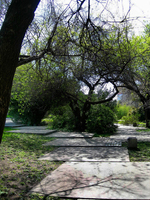 Parque do Museu Calouste Gulbenkian
Parque do Museu Calouste Gulbenkian
Parque do Museu Calouste Gulbenkian »
It is appropriate for an art gallery should be surrounded by a garden which is significant as an example of modernist abstract art.
Read more on Parque do Museu Calouste Gulbenkian
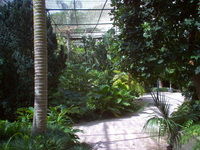 Estufa Fria and Estufa Quente
Estufa Fria and Estufa Quente
Estufa Fria and Estufa Quente »
The hot and cool plant houses are built into a former quarry in Lisbon's central park. The wooden slatted cool house has a delightful atmosphere.
Read more on Estufa Fria and Estufa Quente
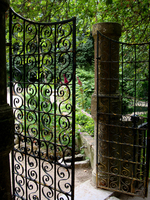 Jardim Botanico, Universidade de Lisboa
Jardim Botanico, Universidade de Lisboa
Jardim Botanico, Universidade de Lisboa »
The botanic garden was founded in 1874 and specialises in trees and shrubs (rather than herbaceous plants). It is a quiet refuge in central Lisbon.
Read more on Jardim Botanico, Universidade de Lisboa
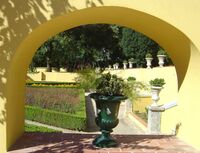 Jardim do Cerco
Jardim do Cerco
Jardim do Cerco »
A baroque garden, made for the Franciscan palace-monastery of Mafra. The palace was designed by the German architect Johann Friedrich Ludwig.
Read more on Jardim do Cerco
 Palacio de Marques de Pombal
Palacio de Marques de Pombal
Palacio de Marques de Pombal »
Had the Baroque continued to evolve as a style of garden layout, instead of being supplanted by the landscape park, a plentiful crop of Rococco gardens would have been made. Pombal Palace gardens show what might have happened elsewere. The gardens are richly decorated with rustic columns and pebble paving. There is also a cascade, a grotto, a pillar, a waterfall with semi-circular basins. It belongs to the Gulbenkian Foundation and is not as well cared-for as it deserves.
Read more on Palacio de Marques de Pombal
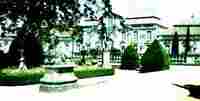 Palacio Nacional de Queluz
Palacio Nacional de Queluz
Palacio Nacional de Queluz »
An old country manor was transformed into an elegant baroque garden between 1747 and 1780. Much of the layout and detailing is French-inspired and was by a French designer (Jean-Baptiste Robillon). Marble stautes were made in Italy and lead statues by John Chere in England. The the tiled canal and bridges are uniquely Portuguese. The upper garden has a parterre with statues of knights. A curved and balustraded staircase, ideal for elegant descents in fine clothes, leads to the lower garden with its glazed canal. During festivities, barges with musicians used to ply the canal. Queluz was a royal garden, designed for royal festivities, but its scale is more intimate than many of its contemporar.....
Read more on Palacio Nacional de Queluz
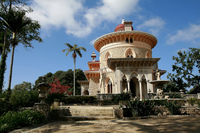 Quinta de Monserrate
Quinta de Monserrate
Quinta de Monserrate »
An English-influenced Mixed Style park was started by William Beckford in the late eighteenth century. Beckford was an exceedingly rich man, famous for his Fonthill estate in England. The waterfall survives from this period. Sir Francis Cook added an exotic Moorish palace in 1856. He employed James Burt to make a series of place-related gardens. They include a Mexican and a Japanese garden.
Read more on Quinta de Monserrate
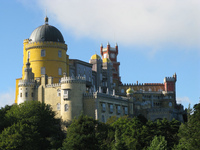 Penha Palace (Palacio da Pena)
Penha Palace (Palacio da Pena)
Penha Palace (Palacio da Pena) »
Palácio da Pena (or Castelo da Pena) was begun in 1839, when the King Consort Dom Fernando II of Saxe Coburg-Gotha purchased the former Hieronymite monastery of Nossa Senhora da Pena. It was built in a hectic-romantic style and surrounded by a gardenesque park and garden, understandably popular with tourists.
Read more on Penha Palace (Palacio da Pena)